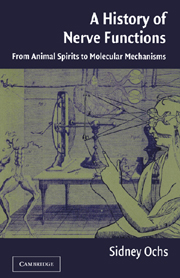Book contents
- Frontmatter
- Contents
- Preface
- 1 Introduction: Greek Science and the Recognition of Nerve as a Channel
- 2 Galen's Physiology of the Nervous System
- 3 Nerve, Brain, and Soul in the Middle Ages
- 4 Renaissance and the New Physiology
- 5 New Physical and Chemical Models of Nerve in the Enlightenment
- 6 New Systematizations of Nerve Function in the Enlightenment
- 7 Electricity as the Agent of Nerve Action
- 8 Nerve Fiber Form and Transformation
- 9 Wallerian Degeneration: Early and Late Phases
- 10 Nerve Regeneration
- 11 Characterization of Axoplasmic Transport
- 12 Molecular Models of Transport
- 13 Actions of Neurotoxins and Neuropathic Changes Related to Transport
- 14 Purposeful Reflexes and Instinctive Behavior
- 15 Neural Events Related to Learning and Memory
- 16 Epilogue: With Observations on the Relation of the Nervous System to Mind
- Bibliography
- Index
5 - New Physical and Chemical Models of Nerve in the Enlightenment
Published online by Cambridge University Press: 13 August 2009
- Frontmatter
- Contents
- Preface
- 1 Introduction: Greek Science and the Recognition of Nerve as a Channel
- 2 Galen's Physiology of the Nervous System
- 3 Nerve, Brain, and Soul in the Middle Ages
- 4 Renaissance and the New Physiology
- 5 New Physical and Chemical Models of Nerve in the Enlightenment
- 6 New Systematizations of Nerve Function in the Enlightenment
- 7 Electricity as the Agent of Nerve Action
- 8 Nerve Fiber Form and Transformation
- 9 Wallerian Degeneration: Early and Late Phases
- 10 Nerve Regeneration
- 11 Characterization of Axoplasmic Transport
- 12 Molecular Models of Transport
- 13 Actions of Neurotoxins and Neuropathic Changes Related to Transport
- 14 Purposeful Reflexes and Instinctive Behavior
- 15 Neural Events Related to Learning and Memory
- 16 Epilogue: With Observations on the Relation of the Nervous System to Mind
- Bibliography
- Index
Summary
Great advances were made in physics after the studies of Galileo, as the findings of other scientists in the sixteenth century led to ever greater accretions of knowledge of physics and chemistry and awareness of the complexities of the nervous system. The latter part of the seventeenth and eighteenth centuries, the period known as the “Enlightenment” or the “Age of Reason,” was characterized by a new critical examination of received teachings. This was the age in which superstition and dogmatic religion were rejected by the Philosophes, the popular philosophers of France. The views on religion held by them and other educated intellectuals included those who believed in a providential God that continually acted on behalf of the affairs of man, the theists, and the deists – those who held that a God may have created the universe, but then left man and the world to run their course without Him. For the atheist, there was no reality at all to God and the soul of man was a material entity that operated by the inherent motion of its substance. This mechano-materialist view was forcibly presented by the English philosopher Thomas Hobbes (1588–1679). For him: “Thought is a form of motion of matter; my ‘ideas’ are vibrations in the matter of my brain and nerves.” In France, the atomism of the ancients was revived by the French philosopher Pierre Gassendi (1592–1655) and used by leading figures in science to advance their theories.
Information
- Type
- Chapter
- Information
- A History of Nerve FunctionsFrom Animal Spirits to Molecular Mechanisms, pp. 63 - 92Publisher: Cambridge University PressPrint publication year: 2004
